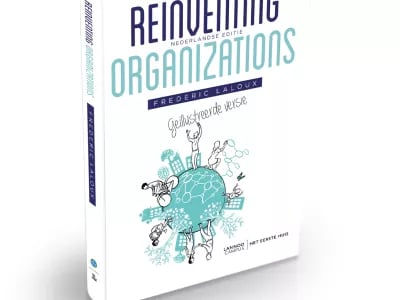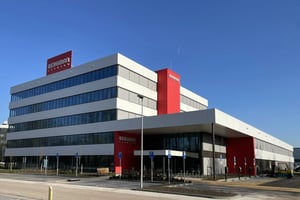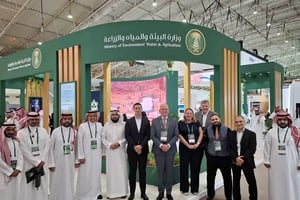Having established himself as a bright new star in the world of organisational theory, Frederic Laloux has joined the ranks of renowned management gurus such as Gary Hamel (of The Future of Management fame) and Barry Schwartz, who wrote the bestselling Why We Work. Laloux, a former McKinsey consultant wrote a remarkable management book titled Reinventing Organizations and it is hailed by many as this decade’s most important book in its genre. So what ideas does Laloux propagate and just what makes them so inspiring?
1. How does Laloux define the term ‘organisation’?
Early on in the book, Laloux advances the theory that humankind has always evolved in stages: from foraging to horticulture and agriculture and ‘ending’ in industrialisation. Each of these stages comes with its own type of society, economy, and different set of power structures. But Laloux argues that organisations – that is, all places where people work together – also evolve with each of these transitions. The changing ways in which people work are giving rise to all new organisational models. Put simply, Laloux feels that organisations merely reflect a specific worldview during a particular time.
2. Why does Laloux use colours to label organisational models?
Although each new organisational model should basically be regarded as an improved version of the model that preceded it, Laloux demonstrates that ‘old’ organisational models are well able to persist past the point where they become outdated. He uses colours to denote these various models. For example, the most basic organisational model of our time is ‘Red’. This model describes an environment where a boss wields a big stick to keep the ‘troops’ in line, dominated by fear as a common denominator and a focus on short-term results.
While this organisational model is mostly a relic in today’s corporate world, it does live on in mafia-style organisations, street gangs and tribal or religious movements. ‘Amber’ organisations (marked by a clear hierarchical structure, duties divided based on highly formal roles within a hierarchical pyramid, top-down authority and control, and with a great emphasis on stability) are also a dying breed within corporations, but are alive and well in the military, education and numerous government agencies and institutions.
3. What is currently the dominant organisational model?
The dominant model in our present-day industrial stage is the performance-oriented ‘Orange’ organisation. The main features of this model are a focus on profit, competition and growth, an emphasis on innovation, and management based on a set of clearly documented targets and objectives. Laloux explains that this type of organisation can be likened to a machine and is common among multinationals, the banking industry and small local businesses.
But since the industrial stage is on its last legs, we are also seeing a growing number of ‘Green’ organisations emerging. These organisations increasingly feel that the machine metaphor no longer suits them and are attempting to shift decision-making responsibility to non-management employees within their organisation. Corporate values and culture, rather than rules and regulations, tend to predominate in these types of organisations. Having an inspiring purpose, supported by highly sophisticated HR practices, helps create motivated employees: in this view, the organisation is a ‘family’. Green organisations also look beyond shareholder interests and consider their role in the wider society.
4. Why does Laloux posit that the industrial stage is on its last legs?
Laloux states that the current way we work in organisations needs to be changed. Many people are disappointed by the way they are put to work in our modern-day ‘Orange’ organisations. Particularly for people at the bottom of the organisation, working means simply buckling down and getting on with the job at hand rather than being driven and inspired to achieve goals. Many organisations keep introducing new change programmes, mergers, new missions and new IT systems, but we have hardly seen any change in how organisations are actually managed. Something has got to give, because sooner or later we are going to hit a wall.
5. But what should the future look like according to Laloux?
He believes we are at the dawn of a new stage of human consciousness, similar to Maslow’s level of ‘self-actualisation’ (Abraham Maslow was an American clinical psychologist – Ed.). In the future, people will no longer be driven by the need to prove themselves, either for their own sake or to others. Instead, they want their life and their work to be meaningful and contribute to others’ wellbeing. Not surprisingly, this also brings with it a new organisational model, which Laloux has assigned the colour Teal.
6. What is a Teal organisation?
In simple terms, a Teal organisation is an organisation which no longer uses its competitive position as a point of departure, but rather the ‘evolutionary goal’ (“Why are we on this Earth?”). There is no longer such a thing as competition: if other organisations replicate a specific strategy, this will only bring us closer to that evolutionary goal. One of the business cases cited by Laloux is the Dutch home-care organisation Buurtzorg.
Buurtzorg is dedicated to helping sick and elderly people to lead more independent and meaningful lives. This mission comes first, and the organisation’s founder, Jos de Blok, makes a point of being transparent when he invites other healthcare providers and explains how his organisation operates. Buurtzorg’s practices have also been carefully documented and published so as to encourage competitors to copy the strategy.
In addition to the ‘evolutionary goal’ described above, Laloux identifies two other key features of Teal organisations. First of all, they are selforganising organisms without central authority or supervisory lines. They are based on selfmanagement and on relationships of equality without a need for hierarchy. These types of organisations lack a middle-management structure while many staff positions found in other organisations are also missing, they are marked by a great sense of responsibility among operational staff, they work on fostering trust as opposed to distrust, and people think in terms of roles rather than job descriptions. Secondly, Teal organisations are holistic in nature: they aim to bring out not only the rational side of employees, but to also make room for their emotional, intuitive and spiritual sides.
7. How do people collaborate in Teal organisations?
Laloux believes that the current relationship between bosses and their subordinates tends to create an unhealthy parent/child-type relationship dynamic. In empowered (also known as ‘selfmanaging’) organisations, the system compels the creation of adult-adult relationships, where a number of ground rules serve to support healthy and productive collaboration.
There is a strong focus in Teal organisations on areas such as reflection and self-reflection, mutual coaching and supervision, and alternative consultation and meeting techniques. Training and education are aimed not only at professional, but also at personal development, and performance reviews are based on a wider perspective than biannual performance criteria alone.
8. Are there many Teal organisations around at this point?
Absolutely. A substantial section of Reinventing Organizations is devoted to cases of existing organisations that meet the above characteristics. And, as Laloux points out, these organisations also happen to achieve above-average success. The paradox is that Teal organisations, while not being consumed by profit, more often than not report outstanding growth and perform better than ‘regular’ organisations. Take Buurtzorg, for example – not only has it managed to increase its workforce by large numbers, it also outperforms other home-care organisations in terms of its financial results.
9. Can existing organisations transform themselves into Teal organisations?
Sure, although Laloux does not offer a blueprint for this as such. Whether and how organisations can transform themselves into Teal organisations is – like so many other aspects – a question of leadership. The main condition, according to Laloux, is for the organisation’s founder/owner or CEO to have a ‘Teal’ mindset. The model, it should be noted, is not confined to any one industry: Teal organisations can be found in the healthcare, profit, not-for-profit and manufacturing industries. The size of the organisation, its location and cultural background would also appear to be irrelevant.
In the final section of the book, Laloux homes in on the question of how organisations can work toward becoming Teal organisations, what some of the pitfalls are, and what practices and processes are the mostessential. Transforming an organisation into a Teal organisation is far from a simple process, but as Laloux explains, if it is successful both management and employees can reflect back on nothing short of a rebirth of their organisation: one that is ready for the next evolutionary stage in our economy and equipped to take maximum advantage of all the opportunities it offers.
10. Has there been criticism of Laloux’ ideas as well?
Laloux has arguably cherry-picked his cases and a study of a mere twelve companies is not sufficient to provide scientific evidence that Teal organisations have the potential to change not only themselves but the world at large – including a leap forward in human collaboration. At the same time, there are also sufficient examples to be found in the Netherlands of companies that have managed to successfully apply Laloux’ theory, including the NPM portfolio company FocusCura.













